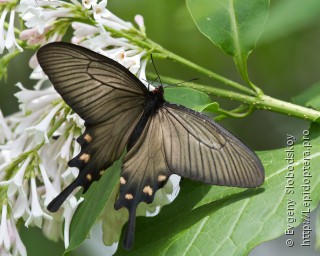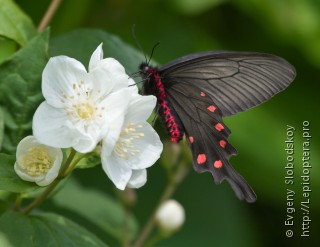Atrophaneura alcinous (Klug, 1836)

Taxonomy
class Insecta → subclass Pterygota → infraclass Neoptera → superorder Holometabola → order Lepidoptera → superfamily Papilionoidea → family Papilionidae → subfamily Papilioninae → tribe Troidini → genus Atrophaneura → species Atrophaneura alcinous
Species name(s)
Atrophaneura alcinous (Klug, 1836) = Papilio spathatus = Papilio haemotostictus = Byasa alcinous = Papilio alcinous Klug, 1836 = Tros alcinous. [3, 9, PC]
Alcinous Swallow-Tail Butterfly, Chinese Windmill.
urn:lsid:insecta.pro:taxonomy:16342
Expansion
This species marks on the maps: 5.
Zoogeographical regions
Palaearctic.
Russia regions
#40. Primorsky.
Wingspan
80—100 mm.
Primary colors
Red, Brown/Gray/Black.
Flight time
| January | February | March | April | May | June | July | August | September | October | November | December |
Over-wintering stage
Pupa.

Detailed information with references
Taxonomy, synonyms and combinations
- Papilio spathatus; Papilio haemotostictus; Byasa alcinous. [PC81].
Distribution
- Regions of the Russian Federation: Seaside. [3].
- Widely distributed in China, Korea and Japan. In Russia, it found only in the south-west of Primorye, which is wedged a small northern part of its range. Colonies altsinoya known in the western parts of the Ussuri, the Nadezhda and in the north of the Khasan district.Temporary colonies observed in the eastern parts of the Ussuri and the Nadezhda district in Vladivostok on the n-ovah Sandy and Jankowski. Lives in mesophytic deciduous and coniferous-deciduous forests, which are located in areas of growth kirkazona Manchu.Distribution of species in a southwest Primorye is limited primarily to the fact that the caterpillar host plant belongs to the rare species. [96].
Imago Habitus and Differences from alike species
- The wingspan of 80-100 mm. Males have black wings on top, females ashen-gray with pronounced black veins. On the hind wings there podkraevye crescent-shaped spots ranked. The underside of the wings brighter. Caudal appendages rear wings are about equal in size-thirds of the wing (with caudal outgrowth).On the sides of the abdomen are red spots [95].
General info about Imago
- Moths of summer generation is much larger than the spring. All fly well, there are a great distance from the habitat. Females are able to migrate, as indicated by the cases of colonization landings kirkazona away from natural habitats (in the Botanical Garden-Institute FEB RAS in Vladivostok, on the Peninsula de Vries) [96].
Imago lifespan
- It flies in two generations - the first generation of butterflies fly from late May to mid-June, the second - from mid-July to late August. [96].
General info about Larva
- Caterpillars hold the bottom of the sheet, usually alone, causing damage to a typical ribbon-shaped scalloped notches deep into the leaf blade. The caterpillars of the summer generation pupate on the stem vine or neighboring trees and shrubs overwintering generation - on the underside of leaves kirkazona. [96].
- Just before pupation can be attached not only to the neighboring trees, but also to various metal objects. [PC238].
Larva food plants / other food objects
- Liana Manchurian Dutchman's pipe (Aristolochia manshuriensis Kom), entered into the Red Book of Russia.
Outside Russia, the caterpillars are met, in addition to kirkazona, on the plants of the genus Kokkulus (Cocculus), family menispermaceae (Menispermaceae). [8].
- In addition Aristolochia manshuriensis fodder plant also a climber Aristolochia contorta [PC238].
Pupa
- Pupae overwintering generation attached to the underside of the leaves, with whom then fall to the ground, where they overwinter in leaf litter. [96].
- Attached via "web" to the trunk and branches of various trees and metal objects [PC238].
- The pupae are attached to the trunks and branches of trees at different heights. Starting from a few centimeters from the ground to a height of 10-15 m [PC238].
- Never saw pupae attached to the former host plant caterpillars. One gets the impression that they do not attach to it (from the literature come from data that pupae are attached to the underside of the sheet?).It turns out that just before pupation larvae crawl out of the food supply and are attached to objects on your own, where they pupate.
Removing caterpillars and pupae of former attachment of host plants is 70 m [PC238].
Egg
- The number of eggs per clutch varies greatly: they increasingly from 3-4 to 15-17, sometimes 24-28. Egg almost spherical, its diameter is 1.4 mm. The total is close to the color of pale reddish-brown (lighter in color reddish-brown eggs give s- shaped curved rows bellied convex bumps).At the top of the egg a small cone-shaped protrusion from the side which rounded mikropillyarnaya area with brown knobby sculpture [120].
Overwintering stage
- The pupae of the second generation [95].
Subspecies of Atrophaneura alcinous
- Atrophaneura alcinous alcinous (Klug, 1836). [85]
- A. a. bradanus (Fruhstorfer, 1908). [85]
- A. a. confusus (Rothschild, 1895). [85]
- A. a. loochooana (Rothschild, 1896). [85]
- A. a. mansonensis (Fruhstorfer, 1901). [85]
- A. a. miyakoensis (Omoto, 1960). [85]
- A. a. yakushimana (Esaki & Umeno, 1929). [85]
Authors
Initial species uploading to the site: Peter Khramov.
Photos:
Evgeny Slobodskoy. Text data: Peter Khramov, Dmitriy Pozhogin, Yuri Semejkin, Irina Nikulina.
The species characteristics formalization: Peter Khramov, Sergei Kotov.
References
- [3] Каталог чешуекрылых (Lepidoptera) России. Под ред. С. Ю. Синёва. СПб.; М.: Товарищество научных изданий КМК, 2008
- [8] Красная книга Российской Федерации (Животные). М.:Астрель 2001
- [9] Tree of Life (funet.fi), 2012
- [85] Lepidoptera species catalogue, Lepidoptera.ru, 2015
- [95] Животный мир уссурийской тайги. Полевой атлас-определитель животных юга Дальнего Востока России. Владивосток: ИПК «Дальпресс», 2004
- [96] Красная книга Приморского края. http://redbookpk.ru/
- [120] Биологические исследования на Горнотаёжной станции. Сборник научных трудов. Выпуск 10. Владивосток, Дальнаука, 2006:
- [PC81] Dmitriy Pozhogin
- [PC238] Yuri Semejkin
Comments
Note: you should have a Insecta.pro account to upload new topics and comments. Please, create an account or log in to add comments
Atrophaneura alcinous photos
Other species Atrophaneura




































































































